Critical Core Review Pt 1
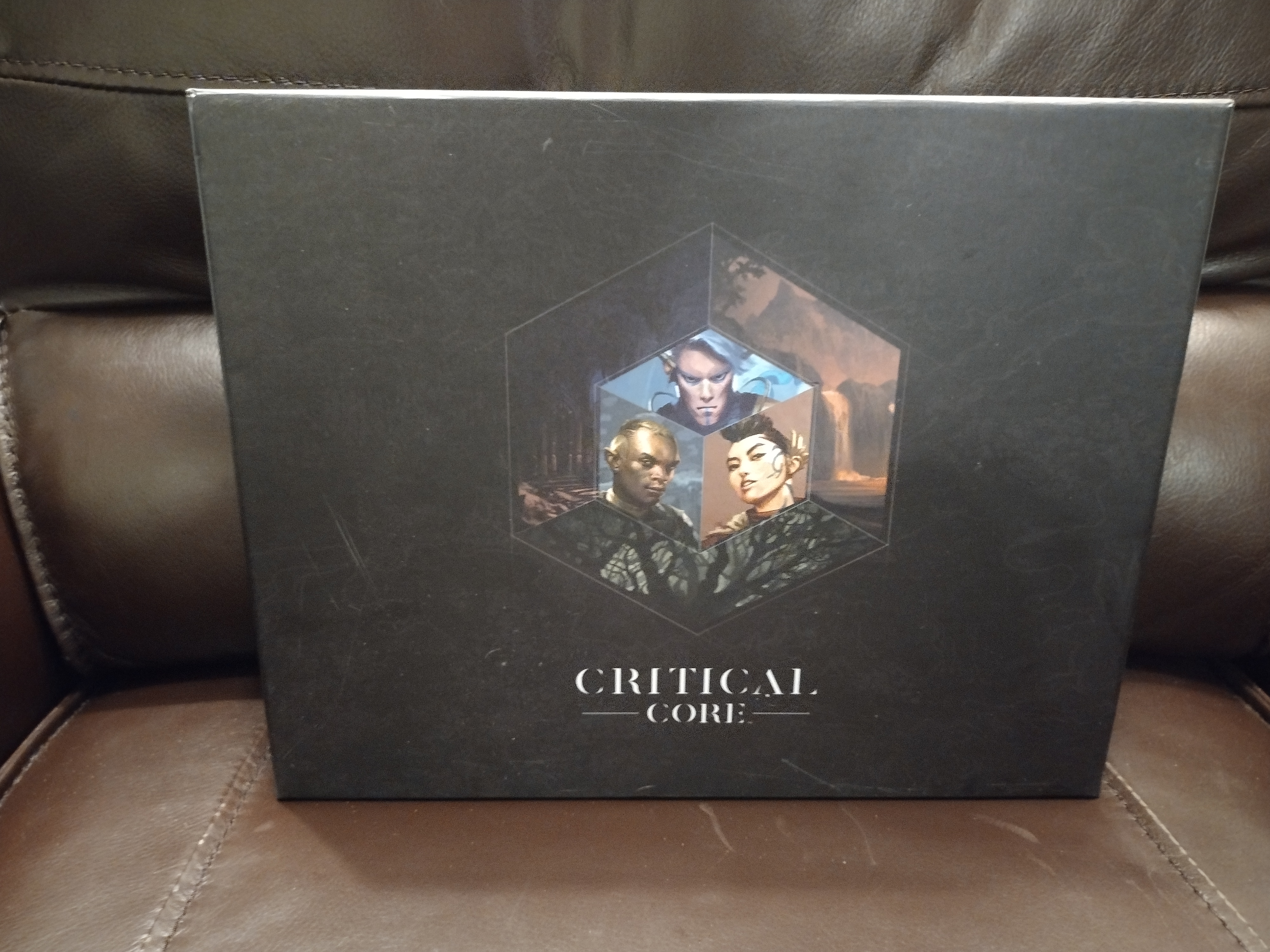
This will be a review of two parts. In this first part it’s just me, David. I’ll provide an overview of the game, look at some interesting design choices, show off the fascinating layout, and conclude with my excitement and hope for our hobby. But I am not a counselor, teacher, or therapist. I’m just a big nerd.
Part 2 features interviews with several counselors, therapists, and teachers who have used RPGs as a teaching tool. We do a much deeper dive on how well Critical Core accomplishes its primary goals.
Part 1: David Learns a Thing or Two Permalink
When I saw the Critical Core pitch on Kickstarter I was immediately hooked.
Critical Core is a tabletop role-playing game designed to help kids on the autism spectrum build social skills and confidence. It’s a great way for parents to engage with their children at home, and for professionals and experienced gamers to use as a group social skills tool.
Obviously, I’m passionate about the positive impact that RPGs can have. I’ve personally benefited from the community and storytelling that emerges from a gaming table. Additionally, my wife has experience working as a behavioral therapist with special needs children. For us, even if Critical Core was a massive failure, we were excited to learn from it and see how Game to Grow tackles this challenge and what we can learn from it.
Thankfully, Critical Core makes some unique design decisions that surprised and delighted me. I learned a few things I hope to apply to my future projects, and I’m excited to share some of those lessons with you, dear reader!
Important Disclaimer: Critical Core is designed to be used by individuals of all training and education backgrounds. Playing role-playing games of any kind can support tremendous growth when played in a safe and welcoming atmosphere and guided by a skilled facilitator. Critical Core contains many tips, tricks, and tools to encourage growth in individuals who are playing at your gaming table. However we must make it very clear: No part of Critical Core gives you permission, either tacit or explicit, to perform therapy without the training or license required in your state or region.
Teaching RPGs to Teachers Permalink

At first glance there’s a lot about Critical Core that is…boring.
- Simplified 5th Edition ruleset
- Competent but uninspiring artwork
- Pre-made characters
- Designed around 3 adventure modules (and ONLY those three adventures)
And I’ll get the bad news out of the way first: Critical Core is difficult to recommend to experienced RPG players. The adventures are not particularly exciting or innovative, the rules are simpler than 5e but still more complex than most OSR fare, and the GM advice is stuff that an experienced GM already knows.
However, Critical Core wasn’t made for me. It is laser targeted towards teachers, counselors, and therapists who think “Dungeons and Dragons” is a demonic sex-thing.
The real question is: “How well does Critical Core explain RPGs to non-nerds?” This aspect is what I hoped to learn from the most.
What IS an RPG, really?? Permalink
If you hated the above phrase, then you’ll dismiss a lot of the important work Critical Core is doing! First, Critical Core rightly emphasizes the important role of the Game Master.
The most unique aspect of TTRPGs like Critical Core is the special role of the game master. The game master is a player who guides the other players through a narrative story composed of a series of individual scenes called encounters. In each encounter, the game master establishes an obstacle that the characters must overcome.
And then come the charts. SO MANY CHARTS! It really does remind me of reading high-school textbooks.
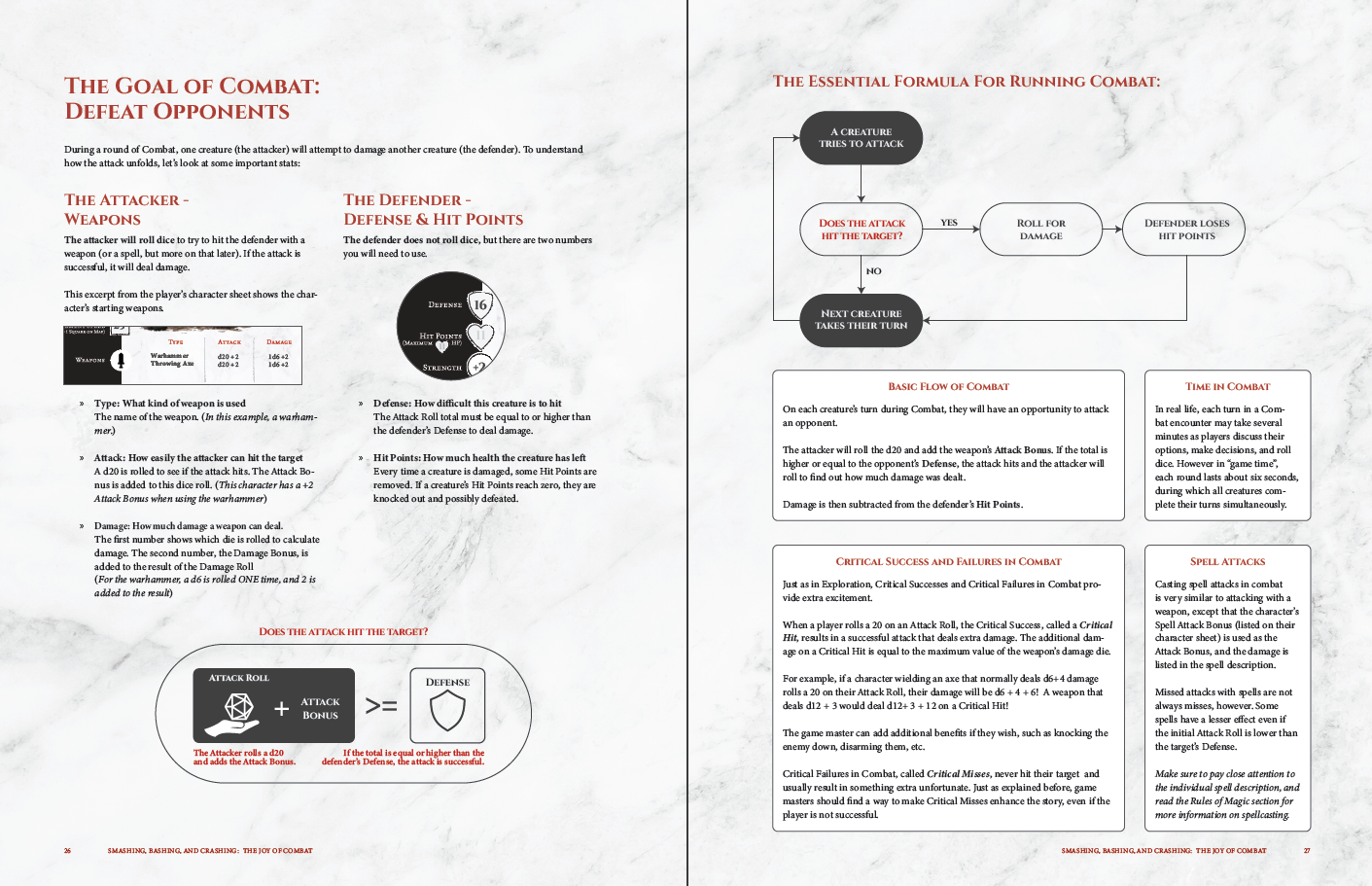
They even include a cheeky acronym: “GMs have S.P.A.R.K.!”. This kind of information presentation felt…goofy to me. Their language is not dry per say, but it’s not as…gritty as what our community tends to use, such as: “The answer is not on your character sheet”, “Rulings over Rules”, “Combat as war”, etc.
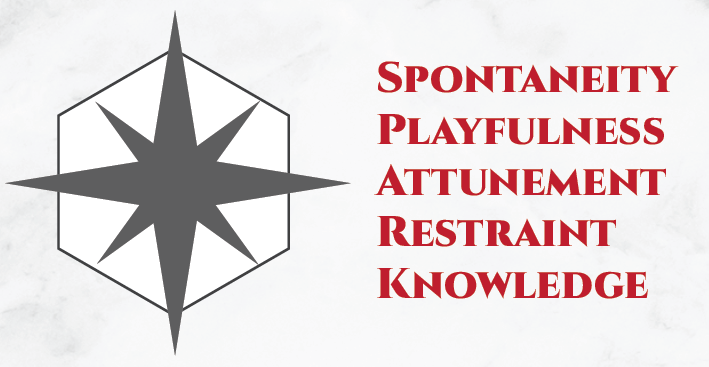
Critical Core emphasizes a few things much more firmly than your average GM guide. For example, they stress that gaming sessions should be 90 minutes long. A game shouldn’t have more than 4 players. They insist that the GM do funny voices and gesticulate. Every 10 or 15 pages includes a summary of all the rules covered so far.
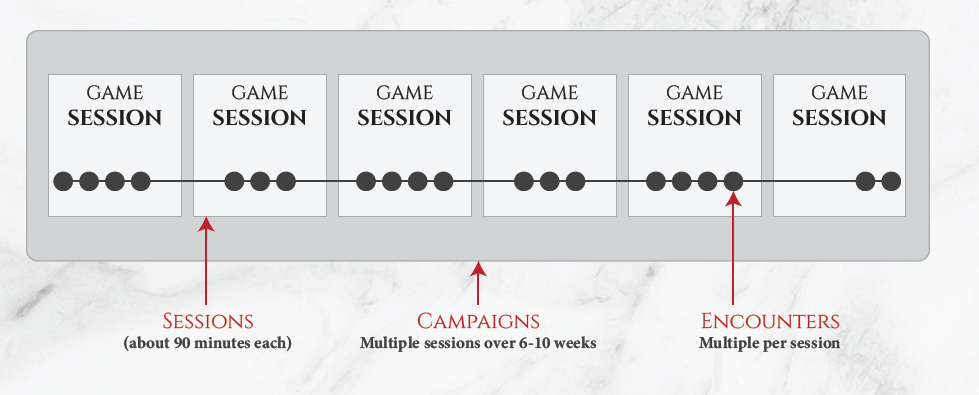
It’s clearly presented with lots of examples and bits of advice scattered throughout. I do think it’s lacking a lot of GM advice that I’ve found useful. It spends about a dozen pages explaining the rules of the game, combat, turn order, damage, dice rolling, etc. But it only spends one or two pages distilling GM advice.
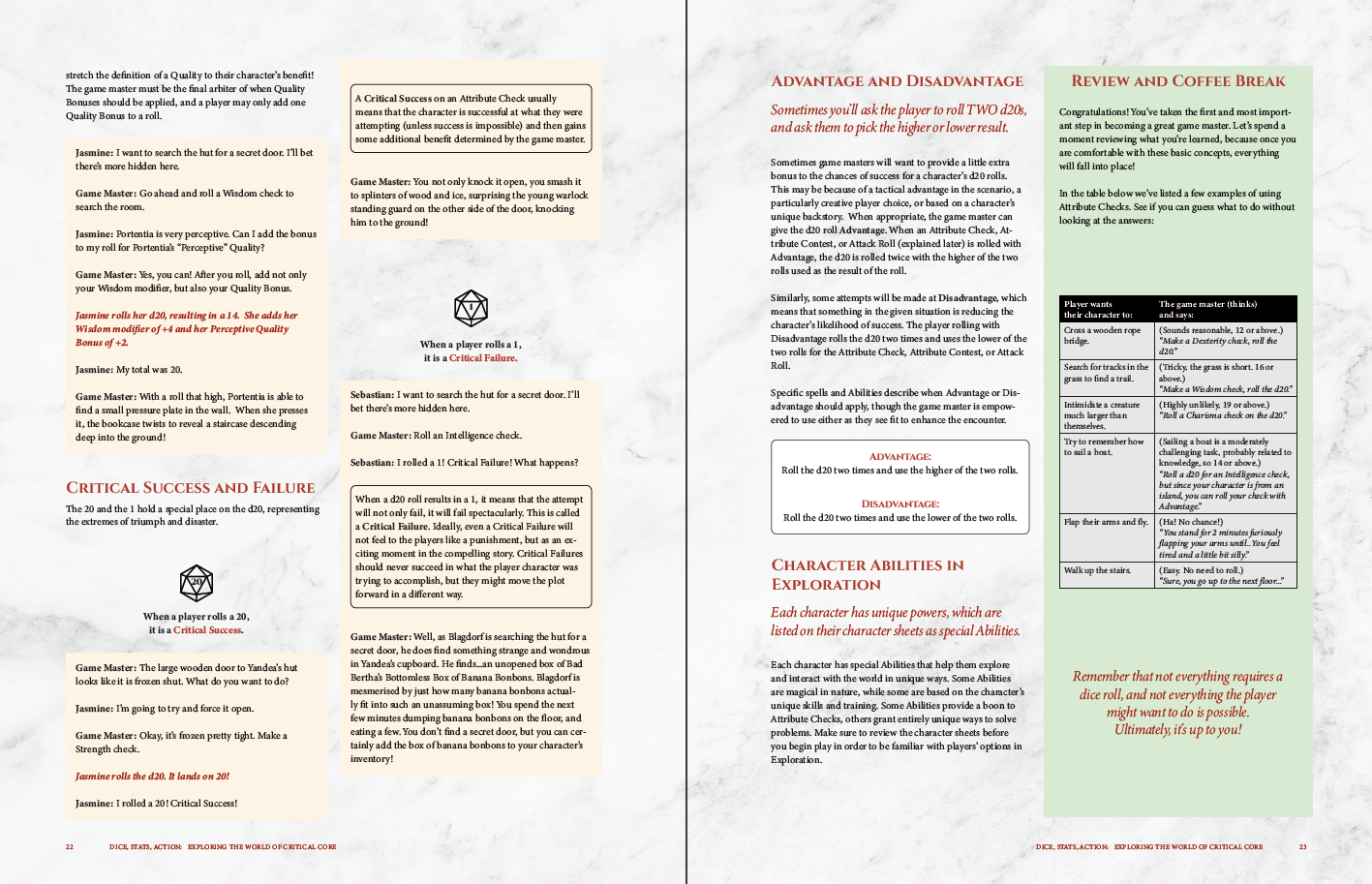
For example, core GMing concepts like “Failing Forward” or “Yes, And” are never discussed. But the book spends a page talking about “Quantum Quandaries”.
The first suggestion should never be the answer, no matter how clever it may be. Every suggestion from the players should get them closer to an answer, even if they fail their roll. When players work together to find a solution, or one player gives up their action in order to help someone else, they should be rewarded with Advantage or a much greater chance of success.
I…don’t think this is very good GM advice. If the first suggestion makes sense, then the GM should allow it! It’s disappointing that many of the improvements we’ve made in teaching effective GM principles is absent in Critical Core.
It’s not ALL bad, it’s just kinda…banal.
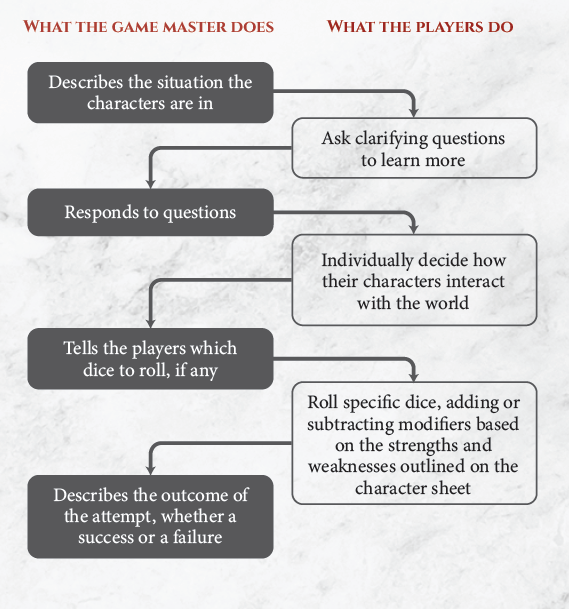
However one innovation that I am a fan of is the role of the Facilitator.
Facilitator VS GM Permalink
Critical Core goes out of its way to separate the role of GM and the role of “Facilitator”.
- The GM is responsible for running the game, tracking the rules, performing NPCs, and tracking pacing.
- The Facilitator is focused more on the players and helping them regulate their emotions, encouraging them, and offering space or support as needed.
The guide admits that the GM and the Facilitator will often be the same person, but explaining them separately is very clever. Personally I love the idea of being a GM while someone more qualified is focused on the players. And I can imagine a teacher being relieved that they don’t have to deal with dice math and goblin voices.
While most of the Facilitator’s guide covers their teaching framework, a few other parts surprised me.
The section titled “Speaking to Therapists and Teachers about Critical Core” was mind-blowing to read. It covers some of the negative stigma that RPGs have, how to overcome that stigma, how to pitch the game to suspicious teachers, etc. It’s only 2-3 pages long but I’ve NEVER seen anything like it. And it gave me a lot of tools I plan to use for future game pitches (especially in a school/counseling setting).
Another surprise was the rigid structure they build around each game session. These are rituals that should occur every session:
- Entering the Space
- Check-In Questions
- Distributing Character Sheets and Dice
- Recapping the Story
- Beginning the Play
- Ending the Play
- Check-Out Questions
- Ending the Session/Leaving the Space
These rituals are a great idea for helping players get into the right headspace for a game, and something I definitely want to include in my own games. Of course, we all do this naturally, but seeing it spelled out and detailed was enlightening. This section is followed by a robust set of safety tools, something I was relieved to see.
For more info on how well Critical Core implements it’s educational goals, definitely read the interviews in Part 2.
Maximalist Layout Permalink
In my review of The Isle I praised its minimal layout. By contrast, the adventures in Critical Core are almost overwhelming with how information is presented. Some information is even repeated multiple times within a single spread!
Each adventure spread is a single encounter. Not a single region or dungeon or hex…just one encounter; a room, a fight, a puzzle, etc. I’ve read OSR adventures that would fit this same amount of content into one sentence or a table entry! What could be the logic behind this extravagant waste of space and letters?
Let’s look at an encounter from the first adventure module. Every encounter has a similar layout with a similar amount of text. If this were an OSR adventure, I would describe the encounter like this:
The flower the PCs have been looking for grows on the roof of an old witch’s hut. This old witch never leaves her home, hurling insults and summoning slimes from inside. Plucking the flower from the top of her roof will be tricky, and if the PCs take too long the witch teleports away, taking her house and slimes with her.
Here is how Critical Core presents that scenario:
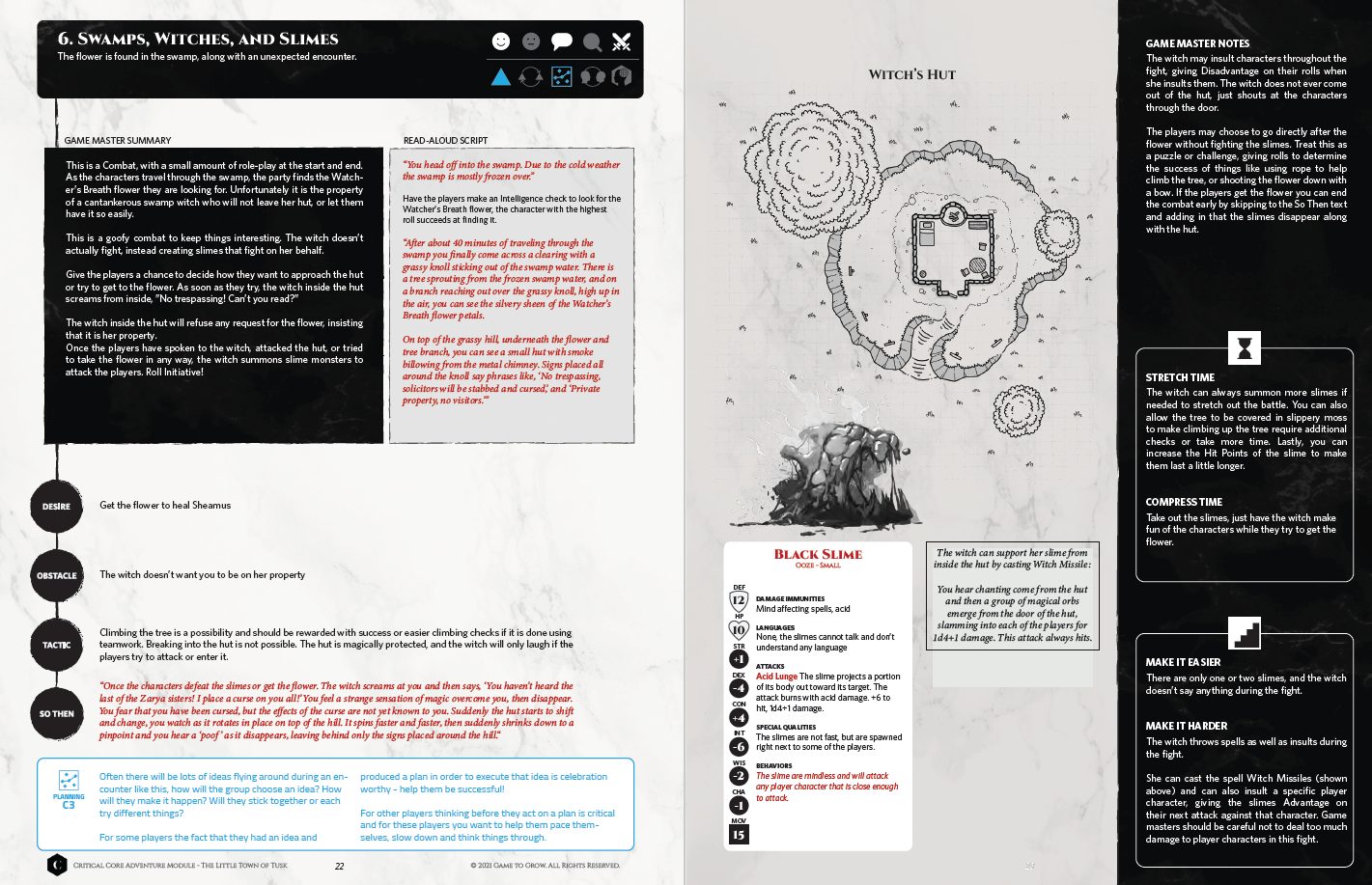
There’s a LOT going on here, but each part is intended to be referenced at a glance when needed.
- The Header shows the tone of the encounter (happy/scary) and the type of encounter (combat vs roleplay vs exploration).
- A Game Master summary is just for the GM while the Read-Aloud Script can be read word for word to the players or paraphrased. These two have similar info, but presented differently.
- DOTS emphasizes the obstacles and goals of the players as well as how to transition into the next encounter.
- The Facilitator section specifies what this encounter is teaching. In this case, it’s encouraging players to come up with a plan before they charge into the fray.
- Artwork and maps are on almost every spread, which is a nice touch.
- Creature Stats are clearly presented and easy to reference.
- GM Notes are like the advice section. They usually include insights into keeping the players focused and how to handle some common scenarios.
- Time Management briefly covers ways to make this encounter take more or less time.
- Difficulty advice for making things easier or harder.
Including time management/difficult tweaks for every single encounter is a fascinating addition! And it’s not just for combat encounters; advice like “have the mayor already know what is happening” or “The necromancer already has the parts they need for their ritual” make it much more likely that GMs can keep things moving along. This makes a lot more sense when you recall that sessions are only 90 minutes long.
Honestly I might steal this idea for some of my own adventures. Pacing is a difficult skill for GMs, and something that designers like myself could provide assistance. Definitely worth thinking about.
The Facilitator sections were my favorite parts to read. I tend to design encounters for novelty; scenarios that feel fresh and exciting. But for Critical Core each encounter teaches a specific skill and notes how it encourages growth. My favorite example comes from another encounter:
Encounter: There is an invisible ghost in the room. The ghost can open the door to the next room, but they must be convinced.
The Facilitator section instructs the GM to pick the shyest, quietest player as the only one who can interact with the ghost. This encourages one player to take the lead and interpret between the GM and the other players, giving that player a chance to lead and shine. Encounters like this really demonstrate how Critical Core is very deliberate about helping its players grow their social skills.
It’s Not For Me Permalink
Unfortunately, as I said earlier, it’s hard to recommend these adventures to an experienced GM who wants unique and exciting adventures. Critical Core is laser-focused on explaining RPGs to a non-nerd audience who plan to use it as a teaching tool.
Thus a lot of my “criticisms” are just simply features that Critical Core is emphasizing.
- “The adventures are so railroady!” but that’s due to the inexperience of the GM, Facilitator, and players. It’s also a requirement for teaching the specific lessons it tries to instill.
- “Just a bucket of cliches” that will feel fresh to a new group, and might even be helpful when exploring more mainstream adventures. If you know that villains often wear black, that can make it easier to jump into future D&D games.
- “Player agency removed in cutscenes” which are necessary to keep the story moving. Since pacing is such an important part of the game structure, I think the occasional “cutscene” can be beneficial.
- “Not as collaborative as it could be” but Critical Core is trying to remove burdens from players and GMs alike. Although there is a weird exception during one of the adventures where the GM is told to help the players make up the details of a big city. That’s quite a jump from railroady adventures to collaborative worldbuilding! I wish Critical Core gave a little more guidance for moments like those.
Lastly, the box set is made of quality materials. The cards, dice, booklets, maps, and pre-made characters are all very nice. Having everything in a box instead of a single book makes it WAY easier for players to just jump in and start playing.
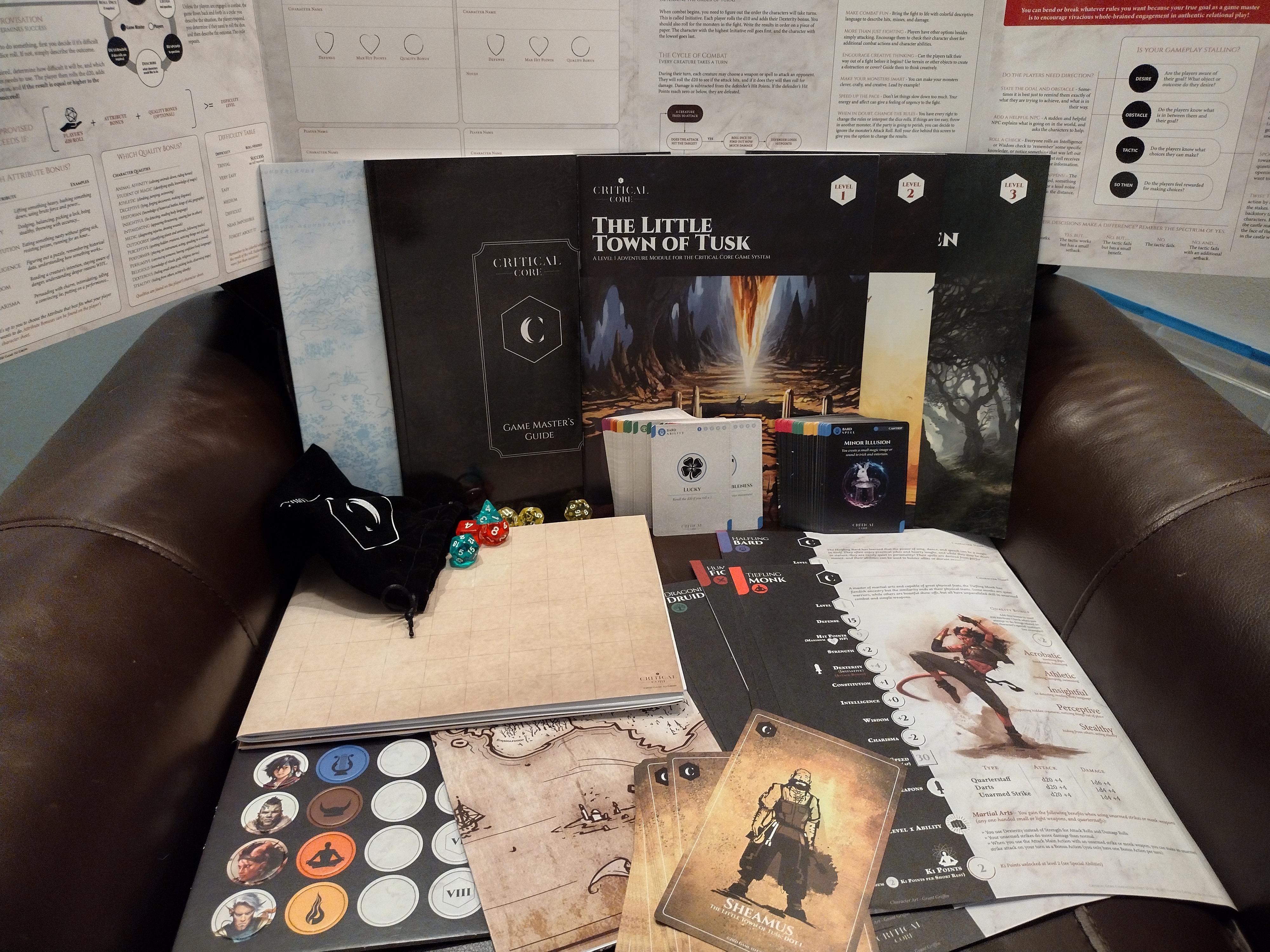
I especially like the Spell cards. Players can easily see what spells they have available and which ones can be used. I wish they had done cards for equipment as well; might help players onboard even faster.
Continued in Part 2 Permalink
Take my review and impressions with a grain of salt. I am not qualified to speak on it’s most important features; the theraputic tools and applications. For that, I interviewed a panel of experts in Part 2!